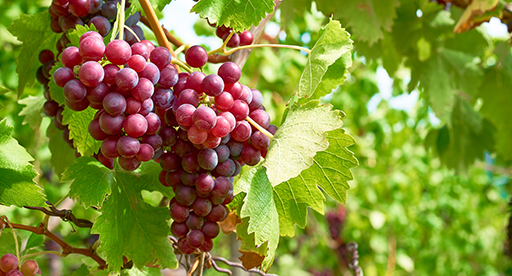
5 Steps to Grape Success
- Choose a spot in full sun with well-draining soil and shelter from cold winds.
- Mix compost and citrus and fruit mix into the soil. Grapes are best planted in late-autumn or early-spring in New Zealand.
- Add Tui Novatec when preparing the soil.
- Feed grapes with blood & bone in early spring.
- Mulch and water well, particularly over the warmer months.
Follow our full guide below to a bumper crop of homegrown grapes.
Grapes are easier to grow at home than you think! With the right support in a sunny spot a few vines will provide a bumper crop of homegrown grapes.
Spilling over a pergola or running along a fence, a well supported and cared for grape vine can put on a beautiful display.
Grape vines begin to fruit two or three years after planting and if they're well looked after can produce fruit for up to a 100 years.
Prepare
Grapes develop the best fruit in long, warm summers, dry autumns, cool winters and crisp, warm springs. While they can tolerate winter frosts, spring frosts can easily kill a growing vine, so they need to be protected in areas where this is a risk. Wet, humid summer weather increases the risk of disease, and if it rains when the fruit is ripening or being harvested the fruit can rot.
Free draining soil is important, grapes prefer lighter stony soils that have been enriched with organic matter, compost and Tui Citrus and Fruit Mix is ideal.
Top table grape varieties for the home garden:
Schyler - Jet-black, medium-sized bunches with a good flavour, juiciness, and sweetness.
Albany surprise - a popular eating grape with large and juicy dark blue-black fruit with a lovely and slightly spicy flavour.
Iona - a very hardy grape that suits coastal areas. It regularly and reliably produces sweet pink-skinned grapes.
Niagara - A popular sweet and juicy green grape that produces large bunches in early season.
Buffalo - Considered by some to be the best of the early black grapes with a sweet, spicy and tart flavour.
Plant
Grapes can be cutting grown or grafted. Grafting prolongs the life of the vine and provides disease resistance, but they grow just as easily from cuttings.
Planting in late autumn is ideal, but if you have harsh winters plant in early spring. Grapes can be planted in pots at any time, a wine barrel or similar size is ideal with a support system for the grape vine to grow up.
Plant in full sun in a sheltered spot, and protect from frosts in spring.
Planting grapes in the garden:
- Prepare the area by lightly working Tui Novatec Premium Fertiliser into the soil.
- Water the roots thoroughly before planting.
- Add a layer of Tui Citrus & Fruit Mix to plant into.
- Dig a hole around 30cm wide and deep and gently loosen the root ball of the plant.
- Fill in with Tui Citrus & Fruit Mix pack it firmly around the plant.
- If your plant is grafted make sure the grafted joint is 10cm above the soil to prevent the root stock rooting.
- For cutting grown grapes plant to the same soil level of the previous pot/container.
- Prune the vines back to two or three buds and train the new growth.
- Provide a support system for the vine, either wires or over a pergola or trellis.
Planting grapes in pots and containers:
- Partly fill the container with Tui Citrus & Fruit Mix.
- Gently loosen the root ball of your plant.
- Place your plant in the pot, and fill in with Tui Citrus & Fruit Mix.
- If your plant is grafted make sure the grafted joint is above the soil, otherwise plant to the same soil level of the previous pot/container.
- Provide a support system for the vine, either wires or over a pergola or trellis.
When planting select the strongest shoot for a central leader to be the permanent ‘trunk’, loosely tie to a stake and remove all other shoots. When the main stem reaches the top of the stake bend it in the direction it needs to go and tie. Remove any side shoots so that the vines energies go into growing the main trunk rather than sending out side shoots.
Only grow one or two main leaders if growing in a container to keep the vine compact as it is growing in limited space, this also helps improve fruit yield.
Nourish
Feed your plants and they will feed you. Grapes need constant soil moisture especially through the warmer months, so adding Tui Compost before summer can help retain the moisture. Beware that too much water can split the fruit, and waterlogging can kill the vines.
In winter remove any side shoots and in spring tie down new shoots onto wires or trellis.
Feed vines with a slow release fertiliser rich in potassium (potash) in spring, such as Tui Novatec.
Grape vines fruit from branches or laterals off one year old stems. Once fruit has set pinch the tips two nodes beyond the bunch so that the vines energies go into producing fruit rather than foliage.
Harvesting
Grapes are ready to harvest from late-summer through autumn depending upon the variety. They don't ripen off the vine, so try one to see if they're sweet enough before harvesting.
Handle the grapes as little as possible and always soak them in water to wash off any grit or bird droppings before you eat them. Grapes are most delicious eaten within two or three days of harvest, any that aren't eaten straight away should be kept in an airtight container in the fridge.
Keep birds off your crop by covering with netting. Make sure the holes are wide enough to let the sun in and ripen your delicious fruit on the vine.